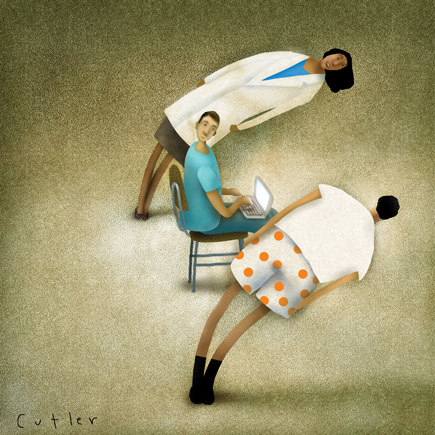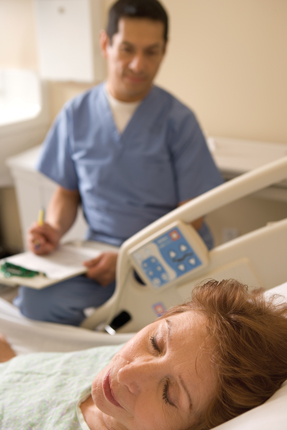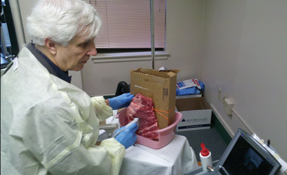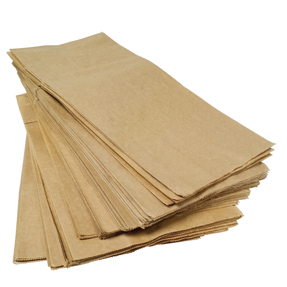Scribes: A write way and a wrong way
Taking a patient's history is considered an intimate part of the exam process, one long-cherished by traditionally minded physicians. Like much of the traditional practice of medicine, it's facing a new model for efficiency. Should doctors delegate the dictation?.
Even after Sandra Kamnetz, MD, became comfortable with using an electronic health record (EHR) in her family medicine practice, she still found the data entry during the exam intrusive and time consuming. She preferred to focus on the patient.
So she tried working with a scribe, someone who is largely trained to serve an EHR-related clerical role, helping the physician to better stay abreast with computer documentation. As computerized medical records have taken root around the country, the new job function has emerged, first in the emergency department and now beginning to migrate into the outpatient setting.

Dr. Kamnetz, who worked with a scribe as part of a pilot project at the University of Wisconsin School of Medicine and Public Health in Madison, said that she'd still be doing so if the funding had continued.
“It allowed me to look at the patient, not look at the computer and be fully engaged with the patient,” said Dr. Kamnetz, vice chair for clinical care in the department of family medicine at the University of Wisconsin School of Medicine and Public Health.
Some physicians, however, worry that introducing another person into the exam setting, as well as the medical record itself, can risk errors and inhibit frank conversation.
“I think there is potential for [the scribe] having an impact on the doctor-patient relationship,” said Mary Noble, MD, FACP, a physician in Spokane, Wash. “When you are a physician, in a room with the patient, it's a pretty sacred situation.”
Until recently, the companies that train scribes have primarily been staffing emergency departments. But physician practices have started expressing interest in the last year or so, said Michael Murphy, MD, chief executive officer of Scribe-America, a scribe training and staffing company based in Lancaster, Calif.
“A lot of doctors' offices are transitioning over to the EMR [electronic medical record],” he said. Dr. Murphy also serves as president of the American College of Clinical Information Managers, which was created in 2010 and formally launched last year to establish an accreditation process for medical scribes.
Still, there's no standardized background or training protocol required at this point of all scribes. A future scribe might be an eager pre-med student, a medical assistant or a transcriptionist, as a few examples. And even supporters of the concept acknowledge that how scribes are trained and used may differ between hospital settings like an emergency department and outpatient physician practices.
Moreover, despite reports from physicians about increased efficiency, data in peer-reviewed journals are scarce, particularly regarding scribe use in the outpatient setting. A few studies have looked at the emergency department impact. According to one retrospective analysis involving one emergency department, switching to regular scribe use can significantly boost the number of patients treated. During a 10-hour shift, 0.8 more patients per hour can be evaluated, according to the results, published in 2010 in Academic Emergency Medicine.
The unanswered question, particularly in the outpatient setting, is whether scribes serve as a temporary crutch amid medicine's transition to computerized documentation or whether their use will become more entrenched, said Ann O’Malley, MD, MPH, a senior researcher at the nonpartisan Center for Studying Health System Change in Washington, D.C.
“In an outpatient setting, it does add a layer of complexity to have a scribe there,” she said. “I don't know if the additional cost of having a scribe is going to be overcome by productivity gains.”
Scribe latitude
The Joint Commission issued some guidance last year regarding the use of scribes, who were defined as unlicensed individuals working with the electronic record under a physician's direction.
Scribes must only document the physician's dictation or activities, according to the guidance, issued in May. They may assist with other related tasks, such as chasing down lab results. But they must not work independently from the doctor. And verbal orders may never be given by scribes or to scribes, The Joint Commission wrote.
Dr. Noble expressed her greatest concern about practice scenarios in which the scribe talks directly to the patient, taking details about the patient's medical history prior to the doctor's arrival.
“The gold is in the history,” said Dr. Noble, who also teaches residents in her capacity as director of the ambulatory care clinic at Internal Medicine Residency Spokane. “Taking a history is a skill.”
But Dr. Noble questioned whether some patients might feel inhibited even when a scribe strives to fade into the documentation background. She's sat on the other side of that experience, when she met with a new doctor and realized that a scribe was present and tapping away on an iPad. Although the visit was for a minor medical issue, “I still found myself feeling a little bit weird,” she said.
The American College of Physicians has not taken any position or written any policies related to the use of scribes, said William Underwood, an ACP senior associate who assists with health IT education. But the addition of scribes does represent a “substantial workaround” of the electronic record, thus risking the loss of clinically relevant information, he said, expressing his own perspective.
For example, if a scribe orders a medication and a warning alert pops up, the doctor won't necessarily see it, he said.
Patient satisfaction
At least in the sensitive environment of a urology visit, patient satisfaction doesn't appear to significantly decline if a scribe is present, according to a study involving five academic urologists, published in 2010 in The Journal of Urology. Patients were randomly assigned to a scribe or nonscribe visit; the scribes remained in the room throughout the doctor's exam and visit with the patient. Patient comfort appeared high, with 93% of those examined with a scribe present expressing satisfaction compared with 87% in the control group.
When Dr. Kamnetz used a scribe, that individual was working on a computer attached to a wall arm, making it feasible for the scribe to stand less intrusively off to one side of the room. Occasionally the patients requested that the scribe step out during a pelvic exam or if there was a mental health concern. But in general, Dr. Kamnetz said, “The patients don't even think about the person in the room. They get used to it.”
At PhysAssist Scribes, a scribe training and staffing company based in Fort Worth, Texas, some scribes have worked for five years without being asked to leave the patient exam room, said Alex Geesbreght, the company president.
To date, the vast majority of the scribes that PhysAssist has hired work in emergency departments. Like other scribe staffing services, PhysAssist touts its extensive training, which in its case includes 30 to 35 hours of classroom and online training, followed by eight to 10 shifts shadowing a physician and an experienced scribe. Just one in 10 people who fill out an application, frequently those already contemplating a career in medicine, successfully complete the training process, according to data provided by the company.
But the field is evolving, and as scribes move into the outpatient setting, they create a new set of challenges for staffing companies and physician practices alike, Mr. Geesbreght said. While an emergency physician group might be comfortable with hiring a cadre of scribes to staff the numerous requisite shifts, a physician practice might not want that many faces shuttling through the office, he said.
Mr. Geesbreght, who repeatedly stressed that scribes serve as patient visit transcribers only, also worries that the scribe could assume a broader role in an outpatient setting. Physician practices may understandably hate to see a paid scribe have any downtime, he said. But Mr. Geesbreght, a malpractice attorney by training, described patient interaction as “an absolutely slippery slope.”
Any solo encounter with a patient could result in a legally risky interaction, he said, providing a hypothetical example. “Then the patient says, ‘Oh, my gosh. I'm having the worst chest pain of my life.’ Let's say the scribe doesn't relay that.”
PhysAssist recently decided to shift its role more toward only training for outpatient practices. Moving forward, a physician practice will identify a physician assistant or other individual it wants to adopt a scribe role. Then PhysAssist provides that training, but the scribe remains a practice employee, Mr. Geesbreght said.
A modified approach
In North Texas, David Bragg, MD, a family practitioner, has adopted what he describes as a modified scribe approach, which he believes improves efficiency while still minimizing any intrusion on patient privacy and the doctor-patient relationship. He started by hiring a second medical assistant in 2010, with the goal of training both assistants to document the time-consuming wrap-up details at the end of a patient visit.
In the paper world, a doctor could check and circle the requisite areas on the form in under a minute, according to Dr. Bragg. Now the computerized documentation may consume five minutes or longer, if the doctor is still adjusting to the new system, said Dr. Bragg. He is also the vice president of medical informatics for HealthTexas Provider Network, made up of roughly 500 North Texas physicians affiliated with Baylor Health Care System in Dallas.
Under Dr. Bragg's new approach, the scribe-like medical assistant rooms the patient, introduces herself and notes that she'll return at the visit's end. Then the scribe leaves while Dr. Bragg conducts the exam and gathers the medical history. “We still have the alone time, which the patients really appreciate,” he said.
Once the scribe returns, positioning herself in front of the computer (and turning on a digital recorder for backup), Dr. Bragg stands before the patient and summarizes the visit's findings, including diagnosis, additional tests needed, dietary recommendations and so on.
After Dr. Bragg leaves, the medical assistant checks the details against the recorder, which allows the patient to hear them for a second time, he pointed out. The result has been that patients appear more satisfied, he said, as do the medical assistants, who appreciate the closer involvement in patient care.
Dr. Bragg, who estimated that about 20 of his HealthTexas colleagues have adopted the modified scribe approach, doesn't feel like there's any increased liability risk, despite the patient interaction involved. “Everything she is doing is under my direction,” he said. “She's not entering any piece of information that either I didn't say or direct her to do.”
In fact, he reported a greater peace of mind, saying the documentation is now more detailed than when he attempted to handle it all himself.
To cover the cost of hiring the second medical assistant, Dr. Bragg estimated that he'd need to see 1.5 more patients each day. Soon he was able to see a total of four more daily. In the first 12 weeks, his total gross charges had increased by 16%, his total patients seen had increased by 25% and his staff overtime was on the downswing.
Learning curve
Doctors who have trained their own scribes do report an initial learning curve. For example, Dr. Kamnetz alerted her scribe that what seemed like chit-chat might be far more important, since she uses the informal approach to gather relevant medical history on the patient. Initially, Dr. Kamnetz spent as much as 45 minutes cleaning up and clarifying the documentation at day's end, but that time commitment decreased to no more than 10 minutes within a few months, she said.
Regardless of training and preparation, though, putting an intermediary between the doctor and the computer system carries some inherent risks, said Scot M. Silverstein, MD, an adjunct professor of health care informatics and information technology at Philadelphia's Drexel University, as well as a frequent critic of EHR usability and effectiveness.
Doctors shouldn't look for the least expensive scribe “because you are asking for trouble,” he said. A careful review of even high-caliber scribes is critical, given their limited clinical knowledge, he added. “There are chances for blur or inaccurate recording or omissions or lost nuances, which in medicine can be quite critical.”
Dr. Silverstein also noted that scribes would likely never have emerged if working with EHRs didn't provide such a “mission-hostile user experience.” If the use of scribes proliferates, they threaten to offset the projected cost savings of computerized medical records, he said.
Nevertheless, Dr. Silverstein believes that scribes are here to stay, as doctors attempt to offset EHR-related declines in productivity. Dr. Noble falls into a similar camp. Some of today's primary care residents will face ever-escalating stress in terms of financial and productivity pressures, she said.
“If using scribes appropriately helps them be more efficient, but still do the right thing, then maybe it needs to be considered,” she said. “But I would hate for patients to be the sacrificial lamb for efficiency.”





